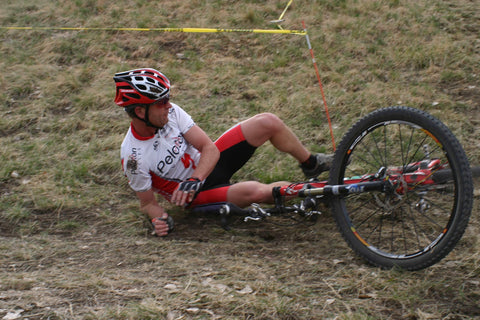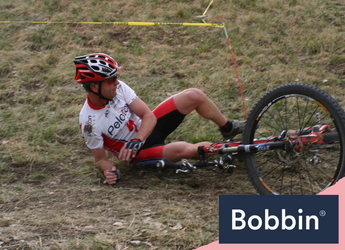Cycling Safety: What to Do if You Have a Cycling Crash
As much fun as cycling is, there’s always some risk involved, despite being accustomed to road safety. Bicycle crashes, in particular, are common experiences for many cyclists. Such mishaps can be distressing, even if minor.
But don’t let this stop you from enjoying the open air and the great outdoors! Simply being aware of your surroundings can keep you safe the majority of the time. If the inevitable does happen, though, it’s important to know what to do. Keep these basic steps in mind to take care of yourself in case of trouble.
Bicycle Crashes and Their Immediate Impact

(Image Credit: Wikimedia Commons)
We can’t always prevent bicycle crashes. They happen when one loses control, is hit by another cyclist, or hits an unseen object in the path. But what you do immediately after the accident can make a difference.
In such situations, you may feel shocked and disoriented. An adrenaline rush can make you act without thinking. Things may get overwhelming, but everything will be alright.
What to Do Immediately After a Bicycle Crash?

If you can move and get off the road, do so. Gather your strength, get out of harm’s way, find a safe place, and start assessing.
Breathe in, breathe out
Take a moment to slow down; take your time getting up and moving around. Wait for your breathing and heart rate to normalise. Sitting or lying down can help with the light-headed feeling.
Assess the damage to yourself. See if you can move your arms in all directions. Can you look up, down, left, and right without pain? Then, decide whether you can pedal off or need to wait for help. Don’t be afraid to ask for aid from those around you; they’ll surely be willing to help.
Administer basic first aid
Look after yourself. Check for any injuries and move your arms and legs to see if you feel any pain. Also, inspect your helmet for cracks or dents. If it's damaged, you might have a concussion and should stay put. Don’t attempt to ride if you feel dizzy.
If you’re feeling okay and your mobility is good, try standing up slowly. If you can walk, you should be able to pedal out of the area.
Note: If you didn’t sustain any injuries but witnessed someone else crash, follow these steps to help them. Call 999 or 112 if needed.
Check the bike
If you’re physically okay and able to get on the bike, ensure your bicycle itself is also in good condition. Check that the wheels are true and the tyres hold air.
The shifters should be properly aligned, and the brakes should be working well. Inspect the frame for any damage that could cause further issues on your way home. This includes the tubing, joints, forks, and any hairline cracks if you have a carbon frame.
For detailed instructions, refer to our guide, ‘How to Perform a Bike Safety Test.’
In the Event of Collision: Vehicle or Road Defects

(Image Credit: Wikimedia Commons)
If you’re involved in a collision with a vehicle, e.g., you’re hit by a car, the situation can become more complicated. Here’s what to keep in mind:
Get details of the other parties involved
After looking after yourself and making sure you’re okay, get the details of anyone involved. If applicable, note the vehicle registration, model, and colour.
Stay calm and avoid arguing. Do not admit fault, either verbally or otherwise, and don’t leave the scene until the incident has been reported. For all you know, they could be a crash-for-cash scammer, so the best etiquette is just to not discuss whose fault it is.
Take photos
Assuming you were hit by a car, take photos to document the damage to your bicycle. Keep any damaged items for inspection and list them, along with any out-of-pocket expenses, as part of your claim. Also, photograph the driver’s number plate if they don’t provide their details.
If the cause is a road defect, like a pothole, your local council might be liable, especially if it resulted in cycling injury and bike damage. Photograph the pothole or defect, and include a reference object like a water bottle to show its size.
If CCTV covers the scene, get a copy. Helmet camera footage can also be useful, but ensure it’s saved and not overwritten. The more detail and evidence you have, the easier it will be to handle any legal claims.
Get witnesses
If there are witnesses, ask if they’re willing to provide an account of what they saw. Collect their names and phone numbers. Their testimony may be needed for damage claims and could be crucial if the case goes to court — though hopefully, that won’t be the case!
Report the incident
If a vehicle is involved, report the incident to the police as soon as possible and within 24 hours. Request the officer’s name and the report date.
If a road defect caused the accident, contact your local council. They can address the issue to prevent future incidents.
Tending Bicycle Crash Injury

It’s always smart to get checked out by a doctor, even if you’re feeling fine after a cycling crash. Concussions are a risk, and there could be long-term effects. Seek urgent care and let the medical professionals assess you.
Head injuries are usually the most serious outcome of a cycling accident, especially if the rider’s head has collided with the concrete ground. Concussions are common, but there can be worse symptoms such as fractures, or even brain damage. An immediate visit to the hospital should be the first priority if any of these are a possibility.
Allow yourself time to rest and heal to prevent further injuries. Your healthcare provider can offer specific recovery guidelines if needed.
Before getting back on your bike, take it to a local shop for a thorough inspection. If your helmet was compromised, invest in a new, quality bike helmet.
Round-up
Cycling accidents, including crashes, can happen, so it pays to be prepared. How you handle the situation can significantly impact your recovery and the extent of bike damage. It also helps to have a dependable Bobbin bike to accompany you on the road, paired with bike accessories that help make your ride smoother and safer.
Note: These pointers are not a substitute for medical advice. In a life-threatening situation, call 999 and seek immediate medical attention.
Up next on your reading list: How Bike Bells Can Keep You Safe on the Road








